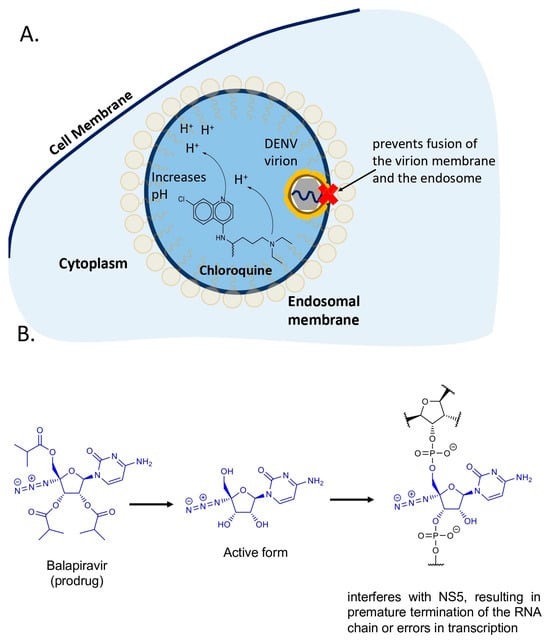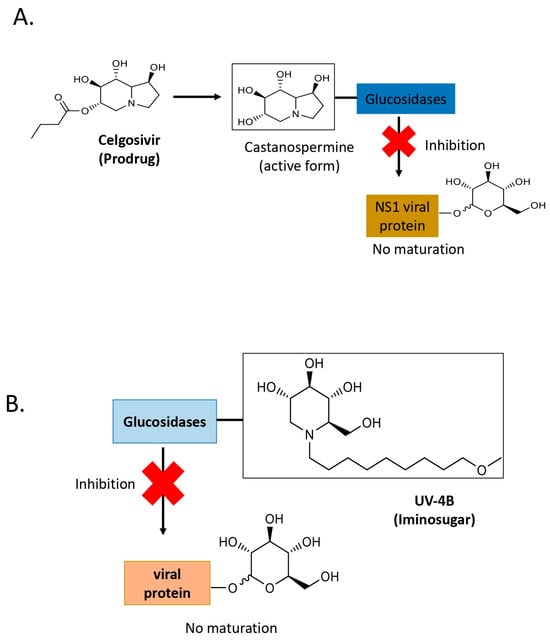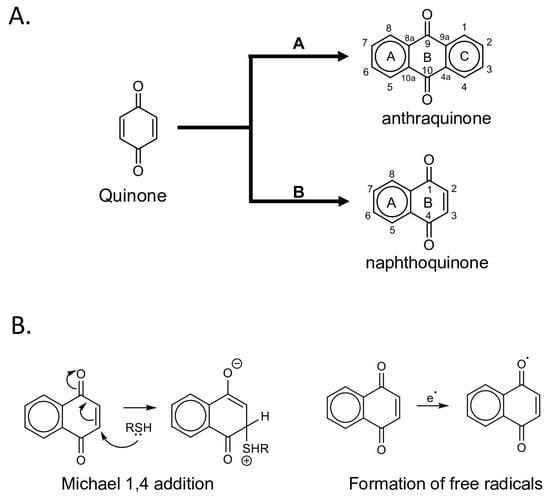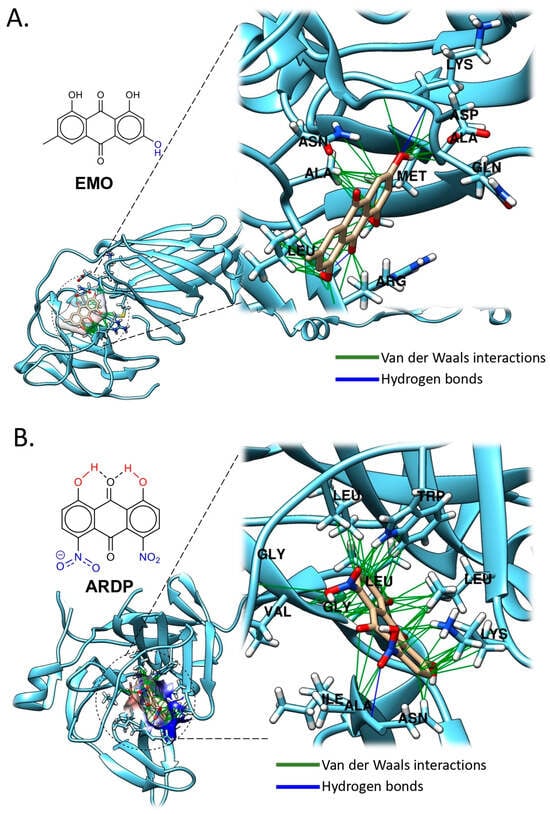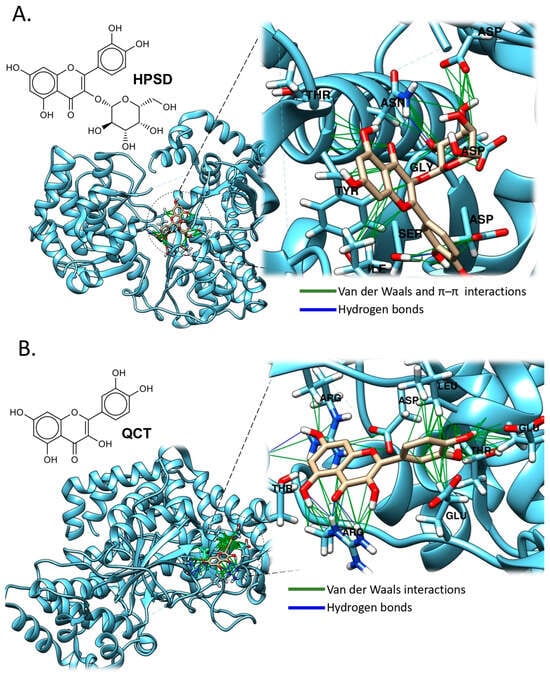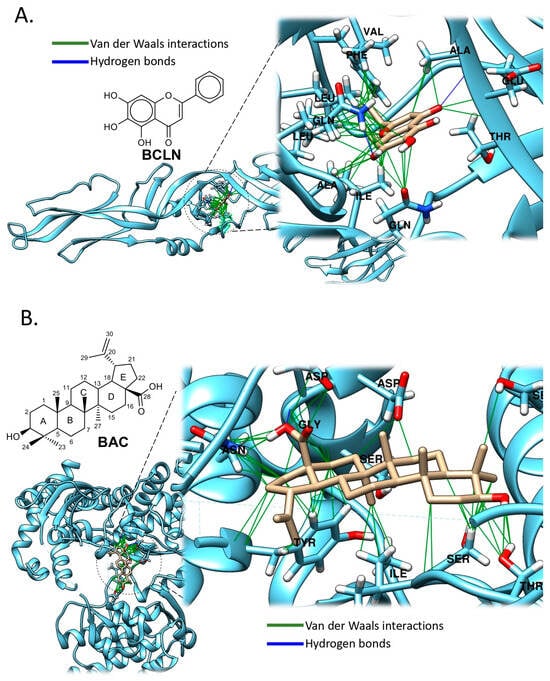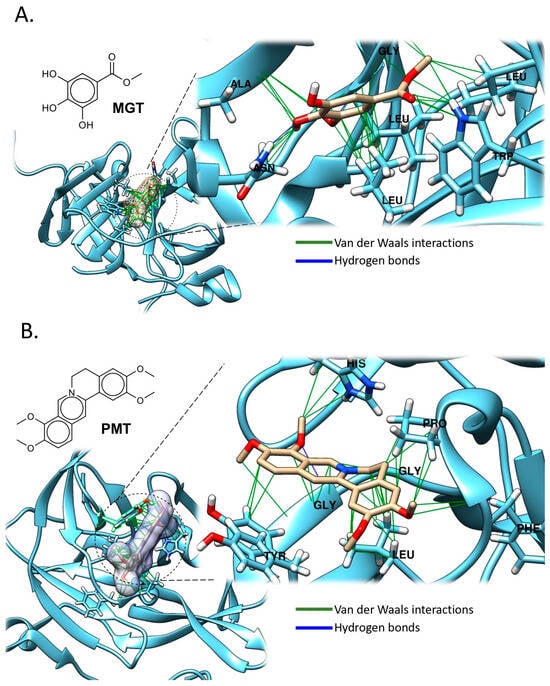Abstract
Arboviruses such as dengue (DENV), Zika (ZIKV), and chikungunya (CHIKV) remain major global health threats, especially in tropical regions, with no effective antiviral treatments available. Recent research highlights progress in identifying antiviral compounds from natural sources against arboviruses belonging to the flavivirus genus, such as DENV and ZIKV. These compounds, derived from plants, marine organisms, and microorganisms, fall into several key chemical classes: quinones, flavonoids, phenolics, terpenoids, and alkaloids. Quinones inhibit viral entry and replication by targeting envelope proteins and proteases. Flavonoids disrupt RNA synthesis and show virucidal activity. Phenolic compounds reduce expression of non-structural proteins and inhibit enzyme function. Terpenoids demonstrate broad-spectrum activity against multiple arboviruses, while alkaloids interfere with early infection stages or viral enzymes. To support the reviewed literature, we performed molecular docking analyses of selected natural compounds and some arboviral proteins included as illustrative examples. These analyses support the structure–activity relationships reported for some natural compounds and highlight their potential interactions with essential viral targets such as the NS2B-NS3 protease and NS5 polymerase. Together, these literature and computational insights highlight the potential of natural products as scaffolds for antiviral drug development.
Keywords:
arboviruses; DENV; ZIKV; natural compounds; quinones; flavonoids; phenolic; terpenoids; molecular docking 1. Introduction
Arthropod-borne viruses (arboviruses) comprise a diverse group of virus families, including Togaviridae, Reoviridae, Bunyaviridae, and Flaviviridae, with a transmission cycle involving vertebrate hosts and arthropod vectors such as mosquitoes or ticks []. Currently, more than 600 arboviruses have been described worldwide, with more than 30% being responsible for millions of symptomatic infections every year in human populations, particularly in tropical and subtropical regions, where more than 40% of people live []. In the case of the mosquito-borne viruses, Aedes aegypti and Aedes albopictus serve as competent vectors in their transmission cycle, facilitating their spread and persistence, with increasing seasonal outbreaks occurring every year in Africa, Asia, and Latin America [].
Among the arboviruses, the Flaviviridae family is considered the most wanted viral family, encompassing over 70 viral species grouped into four genera: Hepacivirus (e.g., hepatitis C virus), Pestivirus (e.g., bovine viral diarrhea virus), Pegivirus (e.g., GBV-A, GBV-D, GBV-C), and Orthoflavivirus. However, other emerging arboviruses that also threaten human public health belong to the Alphavirus (e.g., CHIKV) and the Bunyavirus (e.g., Oropuche virus, OROV) genera []. Overall, these viruses pose substantial public health concerns, underscoring the importance of understanding their molecular characteristics, transmission dynamics, and potential therapeutic targets to develop effective interventions [].
This review article compiles and discusses natural compounds with reported antiviral activity against arboviruses, particularly flaviviruses such as all four dengue virus serotypes (DENV-1 to 4) and Zika virus (ZIKV). In addition, to complement the literature-based discussion, we performed molecular docking analyses of some natural compounds included as a series of illustrative images depicting these interactions. These in silico results are intended to exemplify and visualize the molecular interactions described in previous studies, not to present new experimental data. Flaviviruses are enveloped viruses with a positive-strand RNA genome of ~11 kb with one single open reading frame (ORF) encoding for three structural proteins—capsid (C), precursor membrane (prM), and envelope (E) proteins, and seven non-structural (NS) proteins NS1, NS2A, NS2B, NS3, NS4A, 2k peptide, NS4B and NS5 (Figure 1A). To infect host cells, the outer viral protein—envelope—interacts with its cognate receptor(s) at the cell surface, followed by virus endocytosis. Then, the fusion between the virion and the endosomal membranes leads to the release of the ribonucleocapsid into the cytoplasm, which results in uncoating the viral RNA, eventually translated into a single polyprotein by ribosomes on the endoplasmic reticulum (ER). The polyprotein is then cleaved by the viral protease NS3 and host proteases into structural and nonstructural proteins, all anchored to the ER membrane. Several nonstructural proteins, for instance, NS1, NS4A and NS4B assemble into the replication complex and drive the invagination of the ER membrane to produce replication organelles. In the replication complexes, the viral RNA-dependent-polymerase NS5 (RdRp) in combination with the cleaved NS2A and NS2B-NS3 complex catalyzes the synthesis of the viral RNA that is then packaged into new nucleocapsids and envelopes, creating newly immature virions. Immature virions enter the trans-Golgi Network (TGN) via their secretion in vesicles, where they progress through chambers of decreasing pH. Finally, to exit the host cell, a cellular protease called furin cleaves the precursor peptide (pr) of the pr-M protein, producing mature virions that will be released by exocytosis to infect new naïve (uninfected) cells (Figure 1B) []. The multifaced NS1 protein, the only secreted viral protein during flavivirus infection, facilitates new virus assembly in the ER and the TGN, and triggers immune evasion and pathogenic mechanisms after being secreted from infected cells [,].
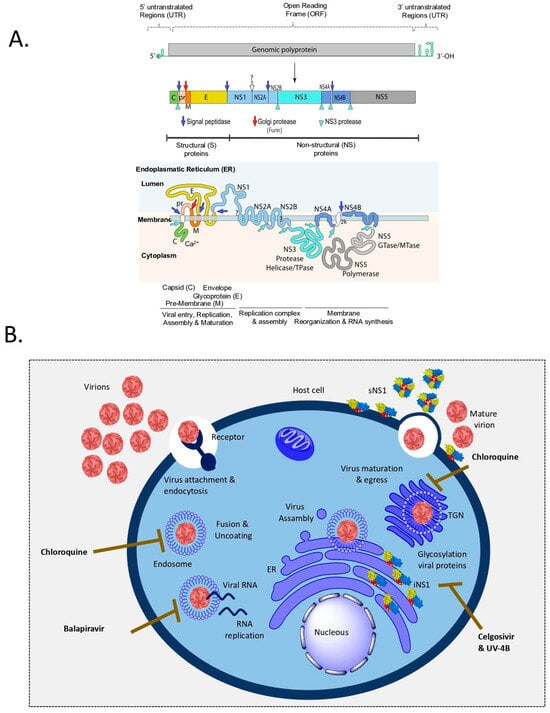
Figure 1.
Genome organization, viral proteins, and replication cycle of Orthoflavivirus. (A) The Orthoflavivirus genome is a positive-sense single-stranded RNA (approximately 11 kb) that contains a single open reading frame (ORF) encoding a viral polyprotein, flanked by two 5′ and 3′ untranslated regions (UTRs). The 5′ end has a type 1 cap, but the 3′ end lacks a poly-A tail. The ORF is translated into a polyprotein, which is then cleaved co- and post-translationally into structural (C, prM, E) and non-structural (NS1–NS5) proteins by host and viral proteases as indicated by the arrows in section (A). Some proteases are still unknown (?). The UTRs contain conserved structural elements vital for the viral life cycle, including RNA replication and translation initiation. (B) Viral infection initiates after the envelope protein of infectious virions interacts with its cognate receptor expressed on the surface of susceptible host cells, leading to virus endocytosis and release of the viral capsid and viral genome (ss + RNA) into the cytoplasm. The translation and cleavage of the viral polyprotein result in three structural proteins (C, M, and E) and seven nonstructural proteins (NS) that, in combination with cellular proteins, catalyze the synthesis of new viral RNA and the assembly of new viral particles. These virions are released by exocytosis to infect new naïve (uninfected) cells. Currently, only four small molecules have shown promising antiviral activity against DENV, including Chloroquine, Celgosivir, Balapiravir, and UV-4B9 that targets various steps of the viral replication cycle, as indicated in (B). Image of the Orthoflavivirus genome structure and viral polyprotein modified by ViralZone, SIB Swiss Institute of Bioinformatics (available at: https://viralzone.expasy.org/24 (accessed on 28 October 2025)).
Currently, no specific treatment exists to combat these arboviral infections. Treatment primarily focuses on symptom management, with no direct impact on viral replication. While few effective vaccines exist for a small number of arboviruses, several vaccine candidates are still under development, for instance, DENV and CHIK. For DENV only two vaccines have been licensed for their administration in humans living in endemic regions, and one more is under a current phase 3 trial []; however, certain safety pre-existing conditions must be fulfilled, such as the immune serostatus of those to be vaccinated before vaccination []. Despite all this evidence, no effective DENV vaccine is yet available [,].
With this unclear panorama, the development of small molecules with potential antiviral activity continues as a promising alternative to defeat these viral diseases; however, finding a suitable and effective drug against these important human arboviruses has been a slow process. To date, four small molecules with promising anti-DENV activity, including chloroquine (ClinicalTrials.gov Identifier: NCT00849602), celgosivir (NCT01619969, NCT02569827), balapiravir (NCT01096576), and UV-4B9 (NCT02061358, NCT02696291), have entered Phase I or Phase II clinical trials (Figure 1B). Despite these promising candidates, no effective antiviral drugs are currently available to treat the arboviral diseases impacting human public health systems worldwide. Today, a vast array of plant, animal, microbial, and marine species yields a plethora of natural products, with diverse chemical structures []. These compounds have been -and will remain- pivotal in drug discovery and development. Plant-derived systems, in particular, offer a rich source of lead compounds for healthcare applications. Recent advancements in elucidating the structures of plant-derived compounds have provided valuable insights into the development of novel drugs, including those targeting cancer, infections, and viral diseases; many natural products have shown particularly promising antiviral activity against arboviruses. Some important natural products and their possible interaction mechanism are discussed below []. Overall, this review presents the current state of knowledge of distinct groups of natural products with promising antiviral activity against arboviruses, particularly the flaviviruses DENV and ZIKV. It includes results from both in vitro and in vivo studies, as well as findings from human trials (Table 1). Furthermore, the structural diversity of these compounds, their viral targets, and their mechanisms of viral inhibition, supported by in silico analyses, are also discussed.
4. Conclusions
Arboviruses such as DENV, ZIKV, and CHIKV continue to spread, causing outbreaks worldwide each year. These viruses pose significant global health challenges due to the lack of effective treatments and the limited availability of vaccines. Natural compounds have emerged as promising candidates for antiviral therapy owing to their diverse biological activities and ability to interfere with viral replication and infection pathways.
In this review, we aimed to integrate the current knowledge on natural compounds with antiviral activity against clinically important human arboviruses, particularly DENV and ZIKV, with illustrative images depicting potential molecular interactions between these compounds and key viral proteins obtained through molecular docking analyses. The combination of biochemical assays and molecular docking studies provides visual and mechanistic insights into the possible binding modes and modes of action of these compounds.
Notably, molecular docking analyses revealed that compounds containing strong polar groups tend to interact with the viral NS2B/NS3 protease, while those with moderate polarity show stronger affinity for the envelope protein, and less polar compounds interact more effectively with the NS5 protein. The structural diversity and potent bioactivity of these natural compounds position them as promising leads for antiviral drug development and the design of new therapeutic molecules.
Overall, this review highlights the current state of antiviral compounds derived from natural sources against human arboviruses. Although several molecules have shown promising antiviral activity by reducing viral titers, no human studies have yet demonstrated effective treatments using these natural compounds against arbovirus transmission in endemic areas. Further clinical evaluations and investigations into combination therapies targeting both viral replication and the host immune response are still needed. Continued research integrating natural product chemistry, virology, and computational modeling holds strong promise for the development of effective antiviral strategies. Such multidisciplinary approaches not only enhance our understanding of antiviral potential but also have the capacity to accelerate the discovery of novel therapeutic agents to combat arboviral diseases.
5. Materials and Methods
This methods section describes the in silico analyses performed here to support the antiviral data reported for those antiviral compounds with inhibitory effect against some arboviruses such as DENV and ZIKV, and includes the different steps for molecular docking analyses. Of note, illustrative images included in Figure 5, Figure 6, Figure 7, Figure 8 and Figure 9 only correspond to those natural compounds with previously identified viral targets potentially involved in viral inhibition. Thus, docking analyses of only those molecules were performed to visualize these interactions.
5.1. Preparation of Proteins
Crystal structures of DENV and ZIKV proteins were acquired from the Protein Data Bank (PDB). PDB IDs: 5JHM (E-ZIKV), 2FOM (NS2B-NS3, DENV-2), 1OKE (Envelope DENV-2), 5K5M (NS5 RdRp, DENV-2) [,,]. By removing all crystal water molecules, the protein structure was prepared for molecular docking processes. Small molecules were removed. The Protein and only the ligands were saved as two separate pdb files for validation docking.
5.2. Pocket Selection for Validation
The validation was carried out by re-docking the original ligand. The validation was performed in triplicate, and the best RMSD value (<2 Å) was selected for the docking of the molecules included in the review. Chimera 1.16 was used as visualization tool.
5.3. Ligand Selection and Preparation
The chemical structures of the small molecules were obtained from the PubChem databases. The 3D PDB structures were generated using Chimera software 1.16. The ligand molecules were subjected to energy minimization using Avogadro [], a tool that applies the MMFF94 force field for energy minimization. Gasteiger charges were added to the small molecules using AutoDockTools 1.5.7.
5.4. Molecular Docking
AutoDock Vina [] (Google Colab environment) was used to perform the molecular docking due to its accuracy and speed. AutoDockTools were used to prepare the input PDBQT files for the proteins and ligands. Polar hydrogens and Kollman charges were added to the three-dimensional structures. The grid box was set to cover the entire protein surface. The validation was performed at the active site of the crystallized ligand. In the case of the molecules used for docking, the analysis was conducted on the entire protein to determine whether the molecules exhibited better binding affinity at any other potential active site. It was confirmed that binding occurs at the known active site.
The following link provides access to the Google Colab environment where the docking simulations were carried out: https://colab.research.google.com/drive/1hHHQVtOpMfhp3a66Txdxp4IEbSVUADUl (accessed on 10 June 2025).
Supplementary Materials
The following supporting information can be downloaded at https://www.mdpi.com/article/10.3390/pathogens14111156/s1.
Author Contributions
J.A.-P.: Investigation, Writing—Original Draft, Docking Analysis, Figure Preparation. R.B.-A.: Review & Editing. H.P.-G.: Visualization, Writing—Review & Editing, Supervision and Submission. All authors have read and agreed to the published version of the manuscript.
Funding
This research received no external funding.
Institutional Review Board Statement
Not applicable.
Informed Consent Statement
Not applicable.
Data Availability Statement
All data is included in the submitted manuscript file.
Acknowledgments
J.A.P. receives a scholarship from the Secretaria de Ciencia, Humanidades, Tecnología e Innovación (SECIHTI, former CONAHCYT) for his doctorate studies at CICY (No. 751354).
Conflicts of Interest
The authors declare no conflicts of interest.
Abbreviations
The following abbreviations are used in this manuscript:
| DENV | Dengue virus |
| ZIKV | Zika virus |
| CHIKV | Chikungunya virus |
| NS | Non-structural proteins. |
| RdRp | RNA-dependent RNA polymerase |
| ER | Endoplasmic reticulum |
| TGN | Trans-Golgi Network |
| FRNT | Focus Reduction Neutralization Test |
| EMO | Emodin |
| GYD | Gymnochrome D |
| ARDP | Anthraquinone ARDP0006 |
| DTQ | Dithymoquinone |
| PyNQ | 1,4-pyranonaphthoquinones |
| GBN | Glabranine |
| 7MGBN | 7-O-methyl-glabranine |
| HPSD | Hyperoside |
| QCT | Quercetin |
| BCLN | Baicalein |
| MGT | Methyl gallate |
| BAC | Betulinic acid |
| EMT | Emetine |
| PMT | Palmatine |
| ABF | Ferruginol |
| TERP | Terpenes |
References
- Caputo, A.T.; Alonzi, D.S.; Kiappes, J.L.; Struwe, W.B.; Cross, A.; Basu, S.; Darlot, B. Roversi, Dengue and Zika: Control and Antiviral Treatment Strategies. Adv. Exp. Med. Biol. 2018, 1062, 265–276. [Google Scholar] [CrossRef] [PubMed]
- Girard, M.; Nelson, C.B.; Picot, V.; Gubler, D.J. Arboviruses: A global public health threat. Vaccine 2020, 38, 3989–3994. [Google Scholar] [CrossRef]
- Rodriguez, A.K.; Muñoz, A.L.; Segura, N.A.; Rangel, H.R.; Bello, F. Molecular characteristics and replication mechanism of dengue, zika and chikungunya arboviruses, and their treatments with natural extracts from plants: An updated review. EXCLI J. 2019, 18, 988–1006. [Google Scholar] [CrossRef]
- Labiod, N.; Chamorro-Tojeiro, S.; de la Calle-Prieto, F.; Gutiérrez-López, R.; Sánchez-Seco, M.P.; Vázquez, A.; Virus, O. A New Emerging Threat. Curr. Infect. Dis. Rep. 2025, 27, 13. [Google Scholar] [CrossRef]
- Li, Q.; Kang, C. Structures and Dynamics of Dengue Virus Nonstructural Membrane Proteins. Membranes 2022, 12, 231. [Google Scholar] [CrossRef]
- Muller, D.A.; Young, P.R. The flavivirus NS1 protein: Molecular and structural biology, immunology, role inpathogenesis and application asadiagnostic biomarker. Antivir. Res. 2013, 98, 192–208. [Google Scholar] [CrossRef]
- Glasner, D.R.; Puerta-Guardo, H.; Beatty, P.R.; Harris, E. The good, the bad, and the shocking: The multiple roles of dengue virus nonstructural protein 1 in protection and pathogenesis. Annu. Rev. Virol. 2018, 5, 227–253. [Google Scholar] [CrossRef] [PubMed]
- Thomas, S.J. Is new dengue vaccine efficacy data a relief or cause for concern? Npj Vaccines 2023, 8, 55. [Google Scholar] [CrossRef]
- Halstead, S.B. Three Dengue Vaccines—What Now? N. Engl. J. Med. 2024, 390, 464–465. [Google Scholar] [CrossRef] [PubMed]
- Obi, J.O.; Guti, H.; Chua, J.V. Current Trends and Limitations in Dengue Antiviral Research. Trop. Med. Infect. Dis. 2021, 6, 180. [Google Scholar] [CrossRef]
- Waickman, A.T.; Newell, K.; Endy, T.P.; Thomas, S.J. Biologics for dengue prevention: Up-to-date. Expert Opin. Biol. Ther. 2023, 1, 73–87. [Google Scholar] [CrossRef] [PubMed]
- Liyanage, N.M.; Nagahawatta, D.P.; Jayawardena, T.U.; Sanjeewa, K.K.A.; Jayawrdhana, H.H.A.C.K.; Kim, J.I.; Jeon, Y.J. Sulfated Polysaccharides from Seaweeds: A Promising Strategy for Combatting Viral Diseases—A Review. Mar. Drugs 2023, 21, 461. [Google Scholar] [CrossRef] [PubMed]
- Zhou, M.; Zhang, R.; Wang, M.; Xu, G.; Liao, S. Prodrugs of triterpenoids and their derivatives. Eur. J. Med. Chem. 2017, 131, 222–236. [Google Scholar] [CrossRef] [PubMed]
- Huang, J.; Song, Q.; Zhang, P.; Deng, L.; Gao, F.; Deng, Y.; Krol, E.; Růžek, D.; Khouri, R.; De Clercq, E.; et al. AntiviralDB: An expert-curated database of antiviral agents against human infectious diseases. MBio 2025, 16, e02013-25. [Google Scholar] [CrossRef]
- Borges, M.C.; Castro, L.A.; da Fonseca, B.A.L. Chloroquine use improves dengue-related symptoms. Mem. Inst. Oswaldo Cruz 2013, 108, 596–599. [Google Scholar] [CrossRef]
- Farias, K.J.S.; Machado, P.R.L.; Da Fonseca, B.A.L. Chloroquine inhibits dengue virus type 2 replication in vero cells but not in C6/36 cells. Sci. World J. 2013, 2013, 282734. [Google Scholar] [CrossRef]
- Kaptein, S.J.; Neyts, J. Towards antiviral therapies for treating dengue virus infections. Curr. Opin. Pharmacol. 2016, 30, 1–7. [Google Scholar] [CrossRef]
- Sung, C.; Wei, Y.; Watanabe, S.; Lee, H.S.; Khoo, Y.M.; Fan, L.; Rathore, A.P.S.; Chan, K.W.K.; Choy, M.M.; Kamaraj, U.S.; et al. Extended Evaluation of Virological, Immunological and Pharmacokinetic Endpoints of CELADEN: A Randomized, Placebo-Controlled Trial of Celgosivir in Dengue Fever Patients. PLoS Negl. Trop. Dis. 2016, 10, e0004851. [Google Scholar] [CrossRef]
- Low, J.G.; Sung, C.; Wijaya, L.; Wei, Y.; Rathore, A.P.S.; Watanabe, S.; Tan, B.H.; Toh, L.; Chua, L.T.; Hou, Y.; et al. Efficacy and safety of celgosivir in patients with dengue fever (CELADEN): A phase 1b, randomised, double-blind, placebo-controlled, proof-of-concept trial. Lancet Infect. Dis. 2014, 14, 706–715. [Google Scholar] [CrossRef]
- Watanabe, S.; Chan, K.W.K.; Dow, G.; Ooi, E.E.; Low, J.G.; Vasudevan, S.G. Optimizing celgosivir therapy in mouse models of dengue virus infection of serotypes 1 and 2: The search for a window for potential therapeutic efficacy. Antivir. Res. 2016, 127, 10–19. [Google Scholar] [CrossRef]
- Sayce, A.C.; Alonzi, D.S.; Killingbeck, S.S.; Tyrrell, B.E.; Hill, M.L.; Caputo, A.T.; Iwaki, R.; Kinami, K.; Ide, D.; Kiappes, J.L.; et al. Iminosugars Inhibit Dengue Virus Production via Inhibition of ER Alpha-Glucosidases—Not Glycolipid Processing Enzymes. PLoS Neglected Trop. Dis. 2016, 10, e0004524. [Google Scholar] [CrossRef]
- Gruner, S.A.W.; Locardi, E.; Lohof, E.; Kessler, H. Carbohydrate-based mimetics in drug design: Sugar amino acids and carbohydrate scaffolds. Chem. Rev. 2002, 102, 491–514. [Google Scholar] [CrossRef]
- Warfield, K.L.; Schaaf, K.R.; DeWald, L.E.; Spurgers, K.B.; Wang, W.; Stavale, E.; Mendenhall, M.; Shilts, M.H.; Stockwell, T.B.; Barnard, D.L.; et al. Lack of selective resistance of influenza A virus in presence of host-targeted antiviral, UV-4B. Sci. Rep. 2019, 9, 7484. [Google Scholar] [CrossRef]
- Franco, E.J.; de Mello, C.P.P.; Brown, A.N. Antiviral evaluation of UV-4B and interferon-alpha combination regimens against dengue virus. Viruses 2021, 13, 771. [Google Scholar] [CrossRef]
- Warfield, K.L.; Plummer, E.M.; Sayce, A.C.; Alonzi, D.S.; Tang, W.; Tyrrell, B.E.; Hill, M.L.; Caputo, A.T.; Killingbeck, S.S.; Beatty, P.R.; et al. Inhibition of endoplasmic reticulum glucosidases is required for in vitro and in vivo dengue antiviral activity by the iminosugar UV-4. Antivir. Res. 2016, 129, 93–98. [Google Scholar] [CrossRef] [PubMed]
- de Castro Barbosa, E.; Alves, T.M.A.; Kohlhoff, M.; Jangola, S.T.G.; Pires, D.E.V.; Figueiredo, A.C.C.; Alves, É.A.R.; Calzavara-Silva, C.E.; Sobral, M.; Kroon, E.G.; et al. Searching for plant-derived antivirals against dengue virus and Zika virus. Virol. J. 2022, 19, 31. [Google Scholar] [CrossRef] [PubMed]
- Pang, X.; Zhao, J.Y.; Liu, N.; Chen, M.H.; Zheng, W.; Zhang, J.; Chen, X.J.; Cen, S.; Yu, L.Y.; Ma, B.P. Anthraquinone analogues with inhibitory activities against influenza a virus from Polygonatum odoratum. J. Asian Nat. Prod. Res. 2021, 23, 717–723. [Google Scholar] [CrossRef]
- El-Najjar, N.; Gali-Muhtasib, H.; Ketola, R.A.; Vuorela, P.; Urtti, A.; Vuorela, H. The chemical and biological activities of quinones: Overview and implications in analytical detection. Phytochem. Rev. 2011, 10, 353–370. [Google Scholar] [CrossRef]
- Malik, M.S.; Alsantali, R.I.; Jassas, R.S.; Alsimaree, A.A.; Syed, R.; Alsharif, M.A.; Kalpana, K.; Morad, M.; Althagafi, I.I.; Ahmed, S.A. Journey of anthraquinones as anticancer agents-a systematic review of recent literature. RSC Adv. 2021, 11, 35806–35827. [Google Scholar] [CrossRef] [PubMed]
- Shao, Q.; Liu, T.; Wang, W.; Liu, T.; Jin, X.; Chen, Z. Promising Role of Emodin as Therapeutics to Against Viral Infections. Front. Pharmacol. 2022, 13, 902626. [Google Scholar] [CrossRef]
- Batista, M.N.; Braga, A.C.S.; Campos, G.R.F.; Souza, M.M.; de Matos, R.P.A.; Lopes, T.Z.; Candido, N.M.; Lima, M.L.D.; Machado, F.C.; de Andrade, S.T.Q.; et al. Natural products isolated from oriental medicinal herbs inactivate zika virus. Viruses 2019, 11, 49. [Google Scholar] [CrossRef]
- Teixeira, R.R.; Pereira, W.L.; Da Silveira Oliveira, A.F.C.; Da Silva, A.M.; De Oliveira, A.S.; Da Silva, M.L.; Da Silva, C.C.; De Paula, S.O. Natural products as source of potential dengue antivirals. Molecules 2014, 19, 8151–8176. [Google Scholar] [CrossRef]
- Chu, J.J.H.; Lee, R.C.H.; Ang, M.J.Y.; Wang, W.L.; Lim, H.A.; Wee, J.L.K.; Joy, J.; Hill, J.; Chia, C.S.B. Antiviral activities of 15 dengue NS2B-NS3 protease inhibitors using a human cell-based viral quantification assay. Antivir. Res. 2015, 118, 68–74. [Google Scholar] [CrossRef] [PubMed]
- Tomlinson, S.M.; Watowich, S.J. Anthracene-based Inhibitors of Dengue Virus NS2B-NS3 Protease. Antivir. Res. 2011, 89, 127–135. [Google Scholar] [CrossRef] [PubMed]
- Roa-Linares, V.C.; Miranda-Brand, Y.; Tangarife-Castaño, V.; Ochoa, R.; García, P.A.; Castro, M.Á.; Betancur-Galvis, L.; Feliciano, A.S. Anti-herpetic, anti-dengue and antineoplastic activities of simple and heterocycle-fused derivatives of terpenyl-1,4-naphthoquinone and 1,4-anthraquinone. Molecules 2019, 24, 1279. [Google Scholar] [CrossRef] [PubMed]
- Roney, M.; Dubey, A.; Nasir, M.H.; Huq, A.M.; Tufail, A.; Tajuddin, S.N.; Zamri, N.B.; Aluwi, M.F.F.M. Computational evaluation of quinones of Nigella sativa L. as potential inhibitor of dengue virus NS5 methyltransferase. J. Biomol. Struct. Dyn. 2024, 42, 8701–8711. [Google Scholar] [CrossRef]
- Da Costa, E.C.B.; Amorim, R.; Da Silva, F.C.; Rocha, D.R.; Papa, M.P.; De Arruda, L.B.; Mohana-Borges, R.; Ferreira, V.F.; Tanuri, A.; Da Costa, L.J.; et al. Synthetic 1,4-pyran naphthoquinones are potent inhibitors of dengue virus replication. PLoS ONE 2013, 8, e82504. [Google Scholar] [CrossRef]
- Gonzaga, D.T.G.; Gomes, R.S.P.; Marra, R.K.F.; da Silva, F.C.; Gomes, M.W.L.; Ferreira, D.F.; Santos, R.M.A.; Pinto, A.M.V.; Ratcliffe, N.A.; Cirne-Santos, C.C.; et al. Inhibition of Zika virus replication by synthetic bis-naphthoquinones. J. Braz. Chem. Soc. 2019, 30, 1697–1706. [Google Scholar] [CrossRef]
- Zhu, Y.; Yu, J.; Chen, T.; Liu, W.; Huang, Y.; Li, J.; Zhang, B.; Zhu, G.; He, Z.; Long, Y.; et al. Design, synthesis, and biological evaluation of a series of new anthraquinone derivatives as anti-ZIKV agents. Eur. J. Med. Chem. 2023, 258, 115620. [Google Scholar] [CrossRef]
- Sánchez, I.; Gómez-Garibay, F.; Taboada, J.; Ruiz, B.H. Antiviral effect of flavonoids on the dengue virus. Phyther. Res. 2000, 14, 89–92. [Google Scholar] [CrossRef]
- Leardkamolkarn, V.; Sirigulpanit, W.; Phurimsak, C.; Kumkate, S.; Himakoun, L.; Sripanidkulchai, B. The inhibitory actions of houttuynia cordata aqueous extract on dengue virus and dengue-infected cells. J. Food Biochem. 2012, 36, 86–92. [Google Scholar] [CrossRef]
- Zandi, K.; Teoh, B.T.; Sam, S.S.; Wong, P.F.; Mustafa, M.; Abubakar, S. Antiviral activity of four types of bioflavonoid against dengue virus type-2. Virol. J. 2011, 8, 560. [Google Scholar] [CrossRef]
- Zandi, K.; Teoh, B.T.; Sam, S.S.; Wong, P.F.; Mustafa, M.R.; AbuBakar, S. Novel antiviral activity of baicalein against dengue virus. BMC Complement. Altern. Med. 2012, 12, 214. [Google Scholar] [CrossRef]
- Loe, M.W.C.; Hao, E.; Chen, M.; Li, C.; Lee, R.C.H.; Zhu, I.X.Y.; Teo, Z.Y.; Chin, W.X.; Hou, X.; Deng, J.G.; et al. Betulinic acid exhibits antiviral effects against dengue virus infection. Antivir. Res. 2020, 184, 104954. [Google Scholar] [CrossRef]
- Allard, P.M.; Leyssen, P.; Martin, M.T.; Bourjot, M.; Dumontet, V.; Eydoux, C.; Guillemot, J.C.; Canard, B.; Poullain, C.; Guéritte, F.; et al. Antiviral chlorinated daphnane diterpenoid orthoesters from the bark and wood of Trigonostemon cherrieri. Phytochemistry 2012, 84, 160–168. [Google Scholar] [CrossRef] [PubMed]
- González-Cardenete, M.A.; Hamulić, D.; Miquel-Leal, F.J.; González-Zapata, N.; Jimenez-Jarava, O.J.; Brand, Y.M.; Restrepo-Mendez, L.C.; Martinez-Gutierrez, M.; Betancur-Galvis, L.A.; Marín, M.L. Antiviral Profiling of C-18- or C-19-Functionalized Semisynthetic Abietane Diterpenoids. J. Nat. Prod. 2022, 85, 2044–2051. [Google Scholar] [CrossRef] [PubMed]
- Rahman, N.A.; Hadinur; Muliawan, S.; Rashid, N.N.; Muhamad, M.; Yusof, R. Studies on Quercus Iusitanica extracts on DENV-2 replication. Dengue Bull. 2006, 30, 260–269. [Google Scholar]
- Low, J.S.Y.; Chen, K.C.; Wu, K.X.; Ng, M.M.-L.; Chu, J.J.H. Antiviral Activity of Emetine Dihydrochloride Against Dengue Virus Infection. J. Antivir. Antiretrovir. 2009, 1, 62–71. [Google Scholar] [CrossRef]
- Jia, F.; Zou, G.; Fan, J.; Yuan, Z. Identification of palmatine as an inhibitor of West Nile virus. Arch. Virol. 2010, 155, 1325–1329. [Google Scholar] [CrossRef]
- Cataneo, A.H.D.; Ávila, E.P.; de Oliveira Mendes, L.A.; de Oliveira, V.G.; Ferraz, C.R.; de Almeida, M.V.; Frabasile, S.; Santos, C.N.D.D.; Verri, W.A.; Bordignon, J.; et al. Flavonoids as Molecules with Anti-Zika virus Activity. Front. Microbiol. 2021, 12, 710359. [Google Scholar] [CrossRef]
- Oo, A.; Teoh, B.T.; Sam, S.S.; Bakar, S.A.; Zandi, K. Baicalein and baicalin as Zika virus inhibitors. Arch. Virol. 2019, 164, 585–593. [Google Scholar] [CrossRef]
- Dewick, P. Medicinal Natural Products: A Byosynthetic Approach, 2nd ed.; John Wiley & Sons Ltd.: Hoboken, NJ, USA, 2002. [Google Scholar] [CrossRef]
- Vázquez-Calvo, Á.; de Oya, N.J.; Martín-Acebes, M.A.; Garcia-Moruno, E.; Saiz, J.C. Antiviral properties of the natural polyphenols delphinidin and epigallocatechin gallate against the flaviviruses West Nile Virus, Zika Virus, and Dengue Virus. Front. Microbiol. 2017, 8, 1314. [Google Scholar] [CrossRef]
- Bourjot, M.; Leyssen, P.; Eydoux, C.; Guillemot, J.C.; Canard, B.; Rasoanaivo, P.; Guéritte, F.; Litaudon, M. Flacourtosides A-F, phenolic glycosides isolated from Flacourtia ramontchi. J. Nat. Prod. 2012, 75, 752–758. [Google Scholar] [CrossRef]
- Mir, A.; Ismatullah, H.; Rauf, S.; Niazi, U.H. Identification of bioflavonoid as fusion inhibitor of dengue virus using molecular docking approach. Inform. Med. Unlocked 2016, 3, 1–6. [Google Scholar] [CrossRef]
- Hanwell, M.D.; Curtis, D.E.; Lonie, D.C.; Vandermeersch, T.; Zurek, E.; Hutchison, G.R. Avogadro: An advanced semantic chemical editor, visualization, and analysis platform. J. Cheminform. 2012, 17, 17. [Google Scholar] [CrossRef] [PubMed]
- Trott, O.; Vina, A.O.A. Improving the speed and accuracy of docking with a new scoring function, efficient optimization, and multithreading. J. Comput. Chem. 2010, 31, 455–461. [Google Scholar] [CrossRef] [PubMed]
Disclaimer/Publisher’s Note: The statements, opinions and data contained in all publications are solely those of the individual author(s) and contributor(s) and not of MDPI and/or the editor(s). MDPI and/or the editor(s) disclaim responsibility for any injury to people or property resulting from any ideas, methods, instructions or products referred to in the content. |
© 2025 by the authors. Licensee MDPI, Basel, Switzerland. This article is an open access article distributed under the terms and conditions of the Creative Commons Attribution (CC BY) license (https://creativecommons.org/licenses/by/4.0/).
